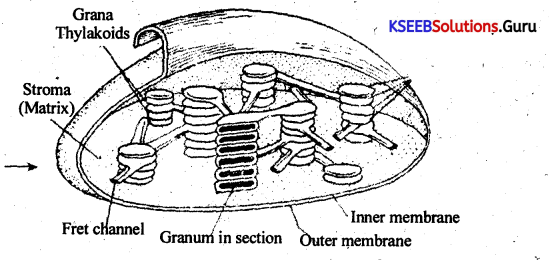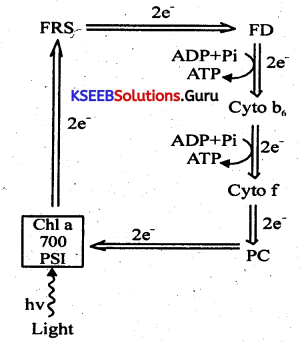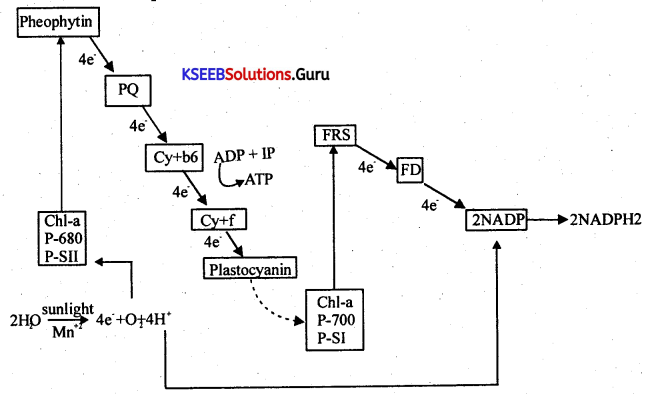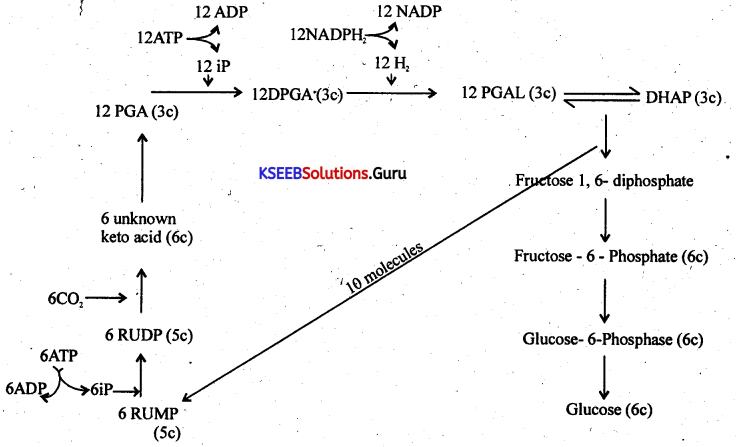Karnataka 1st PUC Biology Question Bank Chapter 13 Photosynthesis in Higher Plants
1st PUC Biology Photosynthesis in Higher Plants One Marks Questions and Answers
Question 1.
Give the general equation for photosynthesis.
Answer:

Question 2.
Name the active pigment involved in photosynthesis.
Answer:
Chlorophyll.
![]()
Question 3.
Name the first stable intermediate compound formed during calvin cycle.
Answer:
Phosphoglyceric acid (PGA).
Question 4.
What is the Red drop effect?
Answer:
Decrease in the rate of photosynthesis when only red light of longer wave length is supplied is called Red drop effect.
Question 5.
What is Emerson’s Enhancement effect?
Answer:
It is the increase in the photosynthetic rate, when red light of shorter, and longer wave lengths are supplied intermittently.
Question 6.
Define solarisation?
Answer:
2000-2500 foot candles of light intensity is optimum for photosynthesis. Higher intensity of sunlight causes photooxidation (bleaching) of photosynthetic pigments. This is referred to as solarisation.
Question 7.
What is photoionization of water?
Answer:
Splitting of water using Zn+2 & Cl– to form protons, electrons and release of molecular oxygen.

Question 8.
Why do you regard calvin cycle as a C3 pathway?
Answer:
The first stable product formed during calvin cycle is phosphoglyceric acid, a3C compound. Hence this cycle is called C3 pathway.
![]()
Question 9.
Name the metallic ion associated with chlorophyll molecule.
Answer:
Mg+2 (Magnesium ion).
Question 10.
Name the energy currency of the cell?
Answer:
ATP Molecules
Question 11.
State Blackmann’s law of limiting factors?
Answer:
It states that “whenever a reaction is conditioned to its rapidity by many separate factors then the rate of the reaction depends on the slowest factor”.
Question 12.
What is the site of the dark reaction of photosynthesis?
Answer:
Stroma of the chloroplast.
![]()
Question 13.
What are C3 Plants?
Answer:
C3 plants are those in which during dark reaction the stable compound formed will be is phosphoglyceric acid, a 3C compound.
Question 14.
Name the first stable compound produced in CAM plants.
Answer:
Oxalo acetic, acid.
Question 15.
Name the primary CO2 acceptor in C4 plants.
Answer:
Phosphoenol pyruvic acid.
Question 16.
By. looking at a plant externally can you tell whether a plant is C3 or C4? Why and how?
Answer:
It is not possible to do so, because only in the anatomy there is a difference between C3 and C4 plants.
1st PUC Biology Photosynthesis in Higher Plants Two Marks Questions and Answers
Question 1.
Draw a neat labelled diagram of a chloroplast?
Answer:

Question 2.
What are the end products of light reaction of photosynthesis?
Answer:
The end products of light reaction are ATP, and NADPH2.
![]()
Question 3.
List any four differences between cyclic and non-cyclic photosynthesis.
Answer:
| Cyclic | Non-CycIic |
| 1. It involves only PS I. | 1. It involves both PS I and PS II. |
| 2. Here photolysis of water takes place. | 2 Here photolysis of water does not take place. |
| 3. Only ATPs are synthesised. | 3. Assimilatory synthesised, powers ATPs, and NADPH, are synthesised. |
| 4. Here the lost electrons from PS I are returned to dil a. | 4. Here, the lost electrons from PS I return back to PS I and PS II does not return them back. |
Question 4.
Give the schematic representation of a cyclic photo phosphorylation.
Answer:

Question 5.
Write any four differences between light and dark reactions of photosynthesis.
Answer:
| Light Reaction | Dark Reaction |
| 1. It depends on light | 1. It is independent of light. |
| 2 It occurs in the grana of chloroplast | 2 It occurs in stroma of chloroplast. |
| 3. Here photolysis of water takes place. | 3. Here photolysis of water does not takes place. |
| 4. Here CO2 fixation does not takes place. | 4. Here CO2 fixation takes place. |
![]()
Question 6.
Explain the law of limiting factors with an example.
Answer:
The law of limiting factor states that “when a process is governed by a number of separate factors, the rate of the process is limited by the pace of the slowest factor”. Photosynthesis is influenced by several factors such as CO2 concentration, availability of water, sun light etc. Any of these factors may become a limiting factor at any one moment, and may limit the rate of photosynthesis.
Question 7.
What is krantz anatomy? Give two examples of plants with krantz anatomy.
Answer:
The presence of a chlorenchymatous bundle sheath is known as krantz anatomy.
e.g: Sugarcane, maize etc.
Question 8.
By looking at which internal structure of a plant, can you tell whether a plant is C3 or C4? Explain.
Answer:
C4 plants contains krantz antonomy which is absent in C3 plants.
Question 9.
Even though only few cells in a C4 plant carry out the biosynthetic – Calvin pathway, they are highly productive. Can you describe why?
Answer:
As Carbon dioxide fixation is very effective in C4 plants, and no accumulation of products in bundle sheath cells takes place, C4 plants are highly productive.
![]()
Question 10.
RuBisCO is an enzyme that acts both as a carboxylase and an oxygenase. Why do you think RuBisCO carries out more carboxylation in C4 plants?
Answer:
Bundle sheath cells are richly supplied with CO2. Under conditions of high CO2 concentration RuBisCO functions only as carbonoylase.
Question 11.
Why is the colour of a leaf kept in the dark frequently turns yellow, or pale green ? Which pigment do you think is more stable?
Answer:
The discolourisation takes place due to degeneration of chlorophyll. Carotenoids are not affected by the absence of light and are more stable.
Question 12.
Give comparison between the following:
(a) C3 and C4 pathways.
(b) Cyclic and non-cyclic photophosphorylation.
(c) Anatomy of a leaf in C3 and C4 plants.
Answer:
(a) C3 plants — C4 plants:
1. Possess parenchymatous or sclerenchymatous bundle sheath.– Posses chlorenchymatous bundle sheath (Krantz anatomy).
2. Perform C3 — Perform C4
3. Primary CO2 acceptor is RUBP — Primary CO2 acceptor is PEP
4. First stable compound formed is PGA (3C). — First stable compound formed is oxalo acetic acid.
![]()
(b)
| Cyclic | Non-CycIic |
| 1. It involves only PS I. | 1. It involves both PS I and PS II. |
| 2. Here photolysis of water takes place. | 2 Here photolysis of water does not take place. |
| 3. Only ATPs are synthesised. | 3. Assimilatory synthesised, powers ATPs, and NADPH, are synthesised. |
| 4. Here the lost electrons from PS I are returned to dil a. | 4. Here, the lost electrons from PS I return back to PS I and PS II does not return them back. |
(c) C3 plants:
1. Possess parenchymatous or or scierenchymatous bundle sheath.
2. Typical granal chioroplasts in Mesophyilcells.
C4 plants:
1. Possess chiorenchymatous bundle sheath.
2. Typical granal chloroplast in mesophyll cells but granal chioro plasts in bundle sheath cells.
1st PUC Biology Photosynthesis in Higher Plants Five Marks Questions and Answers
Question 1.
Write the schematic representation of non-cyclic photophosphorylation.
Answer:
Non-cyclic photophosphorylation is also called ‘Z’ scheme electron transport. In this cycle, the electrons lost by chlorophyll pigment do not return to the same molecule. Both PS I, and PS II are utilised.
One molecule of ATP is formed.
Two molecules of NADPH2 are formed.
One molecule of O2 is formed.

![]()
Question 2.
Give the schematic representation of Calvin cycle/C3 pathway.
Answer:
It occurs in grana of the chioroplast.
It utilises the assimilatory powers i.e., ATP and NADPH2 produced in light reaction.

Answers:
1. Phosphorylation
2. Carbon dioxide fixation
3. Phosphorylation and reduction.
4. Regeneration and RUMP
5. Glucose formation.
Note:- To complete a Calvin cycle, 18 ATPs and 12 NADPH2 molecules are required.
![]()
1st PUC Biology Photosynthesis in Higher Plants Text Book Questions and Answers
- Photosynthesis is a vital anabolic biological process in which green plants synthesise glucose from water, and CO2 by absorbing light energy in the presence of chlorophyll, liberating O2 as a byproduct.
- Chlorophyll containing plastids are called
- Chloroplast is a double membraned, oval shaped cell organelle. Its inner chamber is filled with fluid matrix called
- Embedded in stroma are green coloured bodies called grana, which are interconnected by frets. Granum consists of stacks of circular discs called Each thylakoid contains several photosynthetic centres called quantasomes. Each quantasome contains photosynthetic pigments like chlorophylls, carotenes, and xanthophylls.
- Grana is the site of light reaction.
- Stoma also contains 70s ribosomes, circular DNA and all the enzymes of Calvin cycle. It is site of dark reaction.
- A group of quantasomes are called photosystem or pigment system. It is of two types namely, P-SI and P-SII.
![]()
Chemiosmotic Hypothesis:
It is the hypothesis put forth by the British biochemist Peter Mitchell, which states that energy liberated during electron transport performs osmotic work of accumulating protons or building proton motive force (PMF) across a membrane, which is used to build ATP from ADP, and inorganic phosphate. Proton accumulation occurs in lumen of thylakoid in chloroplasts, and intermembrane space or outer chamber in mitochondria.
Mechanism of photosynthesis:
- Photosynthesis is a light induced redox reaction, in which, water is oxidised to oxygen and CO2 is reduced to carbohydrates.
- It includes two major chemical events. Namely,
- Light Reaction : To produce ATP and NADPH2 → Reducing power
- Dark Reaction : To utilise the reducing power to reduce CO2 to C6 H12 O6
Light Reaction:
- It is a totally light dependent process.
It includes:
(a) Photo excitation of chlorophyll
(b) Photo phosphorylation – cyclic and noncyclic.
(c) Photolysis of water (photo ionisation of water).
Photo excitation of chlorophyll:
Chlorophyll absorbs light energy as photons. Photo excited chlorophyll ejects energised electrons, and becomes positively charged, and remains unstable. It regains stability only when its lost electrons are replaced. The glyceric acid leaves the peroxisomes, and enters the chloroplast, where it is phosphorylated to form PGA.
The PGA enters Calvin cycle, and thus 75% of the carbon lost during oxygenation of RUBP is recovered. Since there is loss of photosynthetically fixed carbon, and no energy rich compound is produced, photo respiration is considered a wasteful process.
![]()
Factors affecting photosynthesis:
The following factors influence photosynthesis:
1. Light: Sunlight is used as a the primary source of energy. Its three aspects affecting the process are:
- Light Intensity: Optimum light intensity for photosynthesis is 2000-2500 foot candles/ Higher light intensity bleaches chlorophyll, and is called solarisation.
- Light Quality: Photosynthetic rate is maximum in red light, next maximum in blue light, and least in green light.
- Duration: Photosynthetic rate is more efficient in intermittent light than in continuous light supply.
2. CO2: Used as a raw material in photosynthesis. Its concentration in air is 0.03%. Its increase upto 0.5% increases the rate of process but above 0.5% inhibits photosynthesis.
3. O2: Liberated as a by product in photosynthesis. Its increase above the normal 21% in air, decreases the rate of the process. It is called Warburg effect,
4. Temperature: It affects photosynthesis through its influence on the enzyme controlled dark reaction. Optimum temperature is 18 – 40°C for photosynthesis.
![]()
5. Water: Used as a raw material in photosynthesis. In the dehydrated state of cells, photosynthesis is inhibited.
Blackmann’s Law of limiting Factors:
The law states that “When a process is conditioned to its rapidity by a number of separate factors the role of the process is limited by the pace of slowest factor”.